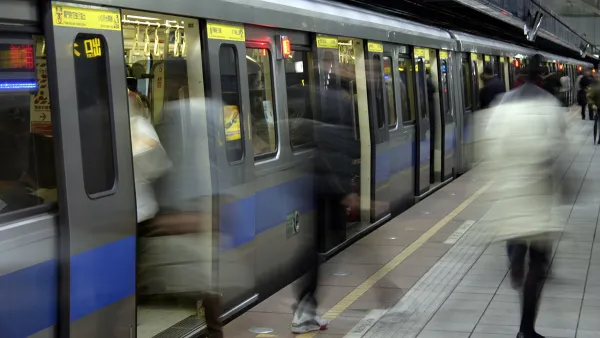Robert Poole reports on efforts across the country to reduce freeway congestion through HOV-to-HOT conversion and public-private partnerships.
Many cities are looking to high occupancy toll (HOT) or express toll lanes, a combination of high-occupancy and toll lanes, to add freeway capacity. Poole looks at efforts in some of the country's most car-dependent cities such as Atlanta, Miami, Houston, Phoenix, Los Angeles, San Francisco, and Seattle to implement such projects.
In Atlanta, "After several years of study, the Georgia Department of Transportation in December 2009 adopted a $16 billion plan to add express toll lanes to nearly all the metro area's freeways."
In Los Angeles, "Los Angeles County is now converting HOV lanes on the Harbor and San Bernardino freeways into HOT lanes. The metropolitan planning agency is considering plans for a region-wide network of such lanes. Projects are in the planning or development stages in Orange, Riverside, and San Bernardino counties. Current plans call for using public-private partnerships to add several missing links to the region's freeway system, including a five-mile toll tunnel on I-710 (beneath South Pasadena) and the planned 63-mile High Desert Corridor in northern Los Angeles County."
The New York Times also ran a piece over the weekend looking at the spread of HOT lanes and their rough introduction in several communities.
While many of the cities Poole identifies are also pursuing expansions to their transit infrastructure, these projects make clear the reality that the private automobile isn't going anywhere fast (unless its paying a toll).
FULL STORY: Unblocking the Box

Maui's Vacation Rental Debate Turns Ugly
Verbal attacks, misinformation campaigns and fistfights plague a high-stakes debate to convert thousands of vacation rentals into long-term housing.

Planetizen Federal Action Tracker
A weekly monitor of how Trump’s orders and actions are impacting planners and planning in America.

In Urban Planning, AI Prompting Could be the New Design Thinking
Creativity has long been key to great urban design. What if we see AI as our new creative partner?

Portland Raises Parking Fees to Pay for Street Maintenance
The city is struggling to bridge a massive budget gap at the Bureau of Transportation, which largely depleted its reserves during the Civd-19 pandemic.

Spokane Mayor Introduces Housing Reforms Package
Mayor Lisa Brown’s proposals include deferring or waiving some development fees to encourage more affordable housing development.

Houston Mayor Kills Another Bike Lane
The mayor rejected a proposed bike lane in the Montrose district in keeping with his pledge to maintain car lanes.
Urban Design for Planners 1: Software Tools
This six-course series explores essential urban design concepts using open source software and equips planners with the tools they need to participate fully in the urban design process.
Planning for Universal Design
Learn the tools for implementing Universal Design in planning regulations.
Gallatin County Department of Planning & Community Development
Heyer Gruel & Associates PA
JM Goldson LLC
City of Camden Redevelopment Agency
City of Astoria
Transportation Research & Education Center (TREC) at Portland State University
Jefferson Parish Government
Camden Redevelopment Agency
City of Claremont



























